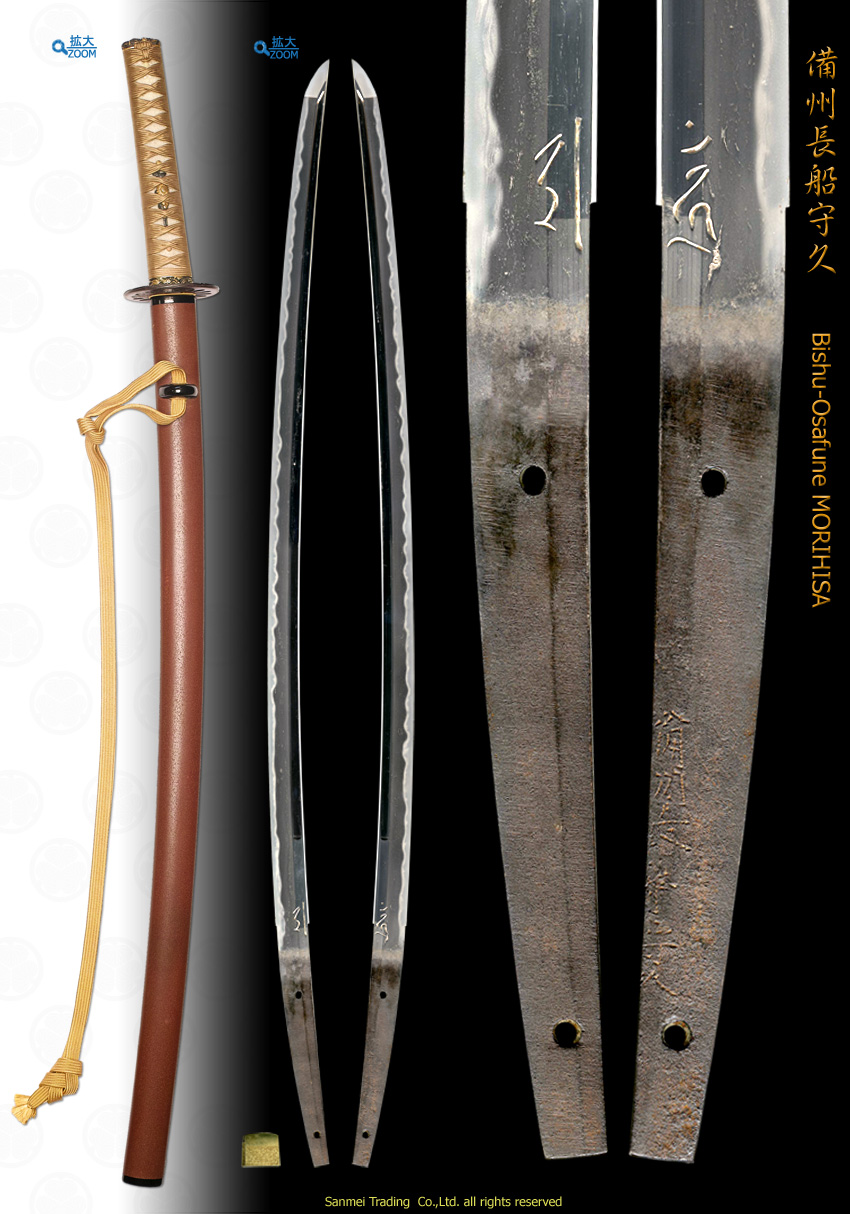with) Brown stone surface lacquered scabbard Uchikatana Koshirae
Length of cutting edge 73.8cm Curvature 1.5cm Width of base 29.0mm Width of Yokote 17.8mm Thickness of base 6.9mm
Horimono(curving) : There is a pair of Sanskrit characters of Bonji each side, above starting point of cutting edge Hamachi and upper is chiselled with Bo-hi grooves on both sides.
Kitae(forging pattern) : Kitae is Itame-hada (fine wooden grain), mixing with Mokume-hada wares. Sparkling hard metal granules of Ji-nie appears and it gives off diffused reflection with abundant mottled sparkling effect so called "Midare-Utsuri" clearly.
Hamon(tempering pattern) : Hamon is a bit on tighter side Nioi boundary line where a bit on stronger side Ko-nie attaches in uniform from base to point. Hamon is undulating Notare with mixing in of Gunome and Togari-ha. The interior is filled in limpid frog of Nioi and active with Ashi and abundant short lines of Sunagashi.
Boshi (tip): Boshi forms undulating Midare-komi then large circle turns back.
Nakago(tang) : The cutting edge is slightly shortened Machi-Okuri on about 4.5cm. 2 Mekugi-ana retaining holes. Slightly leftward file marks Katte-sagari. Back ridge of Nakago being shaved off. The signature is performed in tachi-style on Shinogi-ji, six long character Bishu Osafune MORIHISA 備州長船守久.
The subject tachi created in an archaic style was made by MORIHISA 守久 in Osafune, Bizen province from the 14th C. the period of the Northern and Southern Dynasties. During the 60 years disturbance Nanbokucho period, sword makers raised in power to meet with increasing demand from brave Samurais. Tachi swords became extremely long sublimated such as 3 shaku (90cm) or even more.
The mainstream KANEMITSU 兼光 of the traditional Osafune was still in main force while their branches Kozori 小反り school took a major role of supplement to meet with increasing demand. Whereas individual arisen maker such as Chougi 長義, Motoshige 元重 or Omiya 大宮 school occurred in Bizen province.
According to the NihontoMeikan, MORIHISA 守久 was active during Teiji era (1362-) in the Northern and Southern Dynasties. The original length of this Tachi was as long as about 78.5cm and was being shortened to meet with transition of battle style from Tachi to Kanata in two hundred years during Muromachi period.
This tachi reminds us of it's original shape standing firmly on base, still holds a highly defined curve near the base, generous curved - unrestricted shape with an elongated Chu-Kissaki which is a clear statement of it's age from Nanbokucho. Forging with carefully selected fine steel under traditional Bizen Osafune tradition generates Midare-Utsuri sparkling mottled reflection like a valley where fog hangs low.
Incidental Brown Stone surface lacquered scabbard Uchikatana Koshirae consists of :
(click HERE for entire koshirae / HERE for metal fittings)
- Fuchi/Kashira : Autumn Bugs design, Shakudo, Takabori carving, Gold Iroe inlay, unsigned
- Menuki : A bunch of KIKU flowers design, Shakudo Yobori carving, Gold Iroe
- Tsuba : KIKU flower openwork design, Iron ground, Polish surface, Sukisage carving, Gold Inlay, signed Banshu Akashi-ju Umetada YOSHIKATSU-saku 幡州明石住梅忠義勝作
- Tsuka : White layskin, traditional gold brown silk cord Tsumamimaki style lozenge wrap
Good old polish/Condition scale: excellent - very good (using a scale of mint-excellent-very good-good-fair-poor)
reference data:
Honmas Kunzan/Ishii Masakuni, Nihonto Meikan, Yuzankaku, 1975



